Deutsche Staatsoper Berlin, season 2018/2019
“DIE FRAU OHNE SCHATTEN”
Opera in three acts, Text by Hugo von Hofmannsthal
Music by Richard Strauss
The Emperor SIMON O’NEILL
The Empress CAMILLA NYLUND
The Nurse MICHAELA SCHUSTER
Barak, the Dyer EGILS SILINS
The Dyer’s Wife ELENA PANKRATOVA
The One-eyed Man ADAM KUTNY
The One-armed Man BARTOLOMEO STASCH
The Hunchback KARL-MICHAEL EBNER
The Messenger of Keikobad BOAZ DANIEL
The Voice of a Falcon SLÁVKA ZÁMECNÍKOVÁ
The Apparition of a Youth JUN-SANG HAN
The Guardian of the Threshold EVELIN NOVAK
The Voice From Above NATALIA SKRYCKA
Staatsopernchor, Kinderchor der Staatsoper Unter den Linden
Staatskapelle Berlin
Conductor Simone Young
Chorus Martin Wright
Production Claus Guth
Stage, costumes Christian Schmidt
Costumes Petra Reinhardt
Light Olaf Winter
Choreography Rebecca Howell
Video Andi A. Müller
Berlin, 14th October 2018
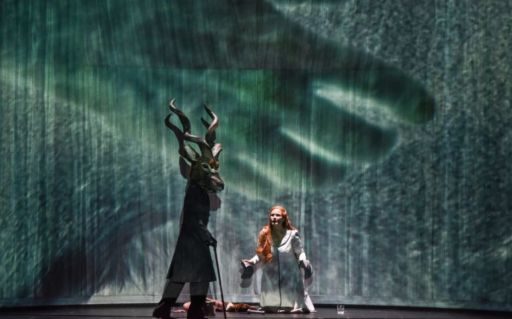 Claus Guth’s staging of Die Frau ohne Schatten already seen at La Scala di Milano and at Covent Garden London reached the Deutsche Staatsoper Berlin in the Schillertheater in 2017. It has now arrived at the renovated Staatsoper Unter den Linden where the production gets the required space to breathe and the music can develop into the abundant sound the score is famous for, the more so as the ceiling of the auditorium was lifted by a few metres in the refurbishment. The opera may be considered the climax of the congenial cooperation between Richard Strauss and his librettist Hugo von Hofmannsthal. They had the model of Mozart’s Die Zauberflöte in mind: a fairy tale with a strong moral dimension. Even though the narrative was largely Hofmannsthal’s invention, he drew on a wide range of sources from The Arabian Nights to Grimm’s Fairytales. FroSch – as Strauss used to abbreviate the project – is along with Salome and Elektra one of the composer’s mightiest and most demanding scores but unlike the other two, it is sophisticated and complex rather than clear and condensed. That is the point where a good opera director comes into play and Claus Guth is undoubtedly one. His approach is simple but effective, he tells the story in a straightforward way avoiding the danger of obscuring Hofmannsthal’s tendency towards the obscure. He opens with a dumb scene before the music sets in: a
Claus Guth’s staging of Die Frau ohne Schatten already seen at La Scala di Milano and at Covent Garden London reached the Deutsche Staatsoper Berlin in the Schillertheater in 2017. It has now arrived at the renovated Staatsoper Unter den Linden where the production gets the required space to breathe and the music can develop into the abundant sound the score is famous for, the more so as the ceiling of the auditorium was lifted by a few metres in the refurbishment. The opera may be considered the climax of the congenial cooperation between Richard Strauss and his librettist Hugo von Hofmannsthal. They had the model of Mozart’s Die Zauberflöte in mind: a fairy tale with a strong moral dimension. Even though the narrative was largely Hofmannsthal’s invention, he drew on a wide range of sources from The Arabian Nights to Grimm’s Fairytales. FroSch – as Strauss used to abbreviate the project – is along with Salome and Elektra one of the composer’s mightiest and most demanding scores but unlike the other two, it is sophisticated and complex rather than clear and condensed. That is the point where a good opera director comes into play and Claus Guth is undoubtedly one. His approach is simple but effective, he tells the story in a straightforward way avoiding the danger of obscuring Hofmannsthal’s tendency towards the obscure. He opens with a dumb scene before the music sets in: a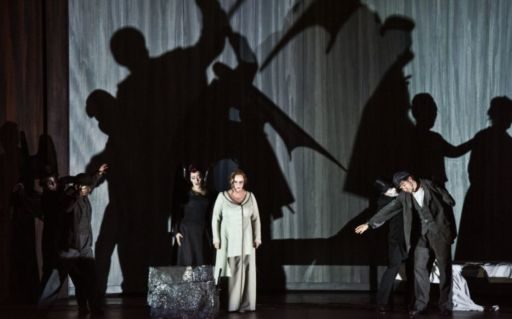 woman is being treated in a sanatorium. She lives through the plot in her dreams, no matter if she becomes or has always been the Empress. So Guth can easily combine the spirit world of Empress and Emperor with the humdrum environs of the Dyer and his wife. While the Empress is present almost all the time, he also elaborates on scenes with the white gazelle (the Empress before discovered and hunted down by the Emperor), the black gazelle (Keikobat, the Empress’s father) and the falcon leading the Emperor to the white gazelle. The fiendish Nurse interacts with the two worlds, sometimes with wings like a bat or vampire. The staging offers much to ponder but never loses the humane, poignant and profound elements of the layered, allegorical fairy tale. Christian Schmidt’s stylish stage and costumes look beautiful with half-round wooden wall elements that can be easily changed for the various scenes strikingly lit by Olaf Winter. I prefer the more than adequate shadow plays to Andi A. Müller’s video projections showing fish or sperms and crying foetuses in the womb. Simone Young conducts the Staatskapelle Berlin with a pleasant and knowledgeable implicitness. She develops the great Strauss sound of the 120 instruments, dissonance and harmony go hand in hand, and there is superb playing with fabulous solos from the violin, cello, bassoon and horn.
woman is being treated in a sanatorium. She lives through the plot in her dreams, no matter if she becomes or has always been the Empress. So Guth can easily combine the spirit world of Empress and Emperor with the humdrum environs of the Dyer and his wife. While the Empress is present almost all the time, he also elaborates on scenes with the white gazelle (the Empress before discovered and hunted down by the Emperor), the black gazelle (Keikobat, the Empress’s father) and the falcon leading the Emperor to the white gazelle. The fiendish Nurse interacts with the two worlds, sometimes with wings like a bat or vampire. The staging offers much to ponder but never loses the humane, poignant and profound elements of the layered, allegorical fairy tale. Christian Schmidt’s stylish stage and costumes look beautiful with half-round wooden wall elements that can be easily changed for the various scenes strikingly lit by Olaf Winter. I prefer the more than adequate shadow plays to Andi A. Müller’s video projections showing fish or sperms and crying foetuses in the womb. Simone Young conducts the Staatskapelle Berlin with a pleasant and knowledgeable implicitness. She develops the great Strauss sound of the 120 instruments, dissonance and harmony go hand in hand, and there is superb playing with fabulous solos from the violin, cello, bassoon and horn. 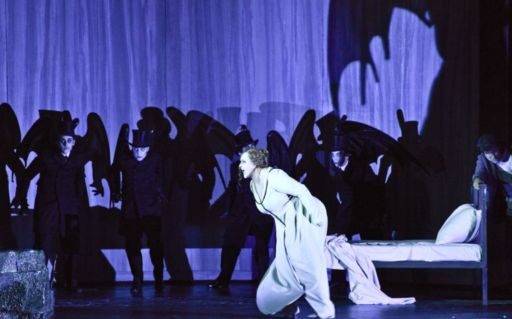 The cast is also top-notch across the board. Given the tremendous vocal requirements of the solo parts, I can hardly think of a better cast nowadays. The title role used to be the warhorse of the unforgotten Leonie Rysanek for nearly thirty years. Camilla Nylund is the vocal focus as well repeating her extraordinary Empress of last year’s run. Her technique is impeccable and her sheer endless vocal stamina admirable allowing her to support the high soprano tessitura and handle the coloraturas, trills and a flawless top D as well as dramatic outbreaks. And she still has the power to turn the big scene “Vater, bist du’s?” into the highlight of the third act. Bravo! Elena Pankratova is not less fascinating as the deeply felt Dyer’s Wife. Her resonant and punchy soprano offers a perfect mixture of warm timbre and tonal beauty, the voice can cope with the heavily orchestrated passages and soars aloft effortlessly so that the final C sung along with the Empress becomes a sound orgy rarely heard since the era of Nilsson and Rysanek. Michaela Schuster is a great actress to make the Nurse pull the strings and her steely mezzo-soprano convincingly conveys the ambiguous maliciousness of the character. There may be half a dozen of singers only who can pull off the fearsome part of the Emperor. Simon O’Neill is one of them, able to cut through the heavy orchestral textures with his sharp-focused and powerful tenor in his uppermost range. Barak’s upright human character makes us sympathise with him from the outset and Egils Silins as one of the much sought-after Dyers over the last ten years, delivers a compelling portrayal between despair and hope, his predicament seems real. His bass-baritone with sufficient power sounds creamy and mature with a slightly Northern touch. There is excellent work in the smaller parts, too such as Boaz Daniel’s winged Messenger, Jun-Sang Han’s Youth or Slávka Zámečníková’s Falcon to name but a few.
The cast is also top-notch across the board. Given the tremendous vocal requirements of the solo parts, I can hardly think of a better cast nowadays. The title role used to be the warhorse of the unforgotten Leonie Rysanek for nearly thirty years. Camilla Nylund is the vocal focus as well repeating her extraordinary Empress of last year’s run. Her technique is impeccable and her sheer endless vocal stamina admirable allowing her to support the high soprano tessitura and handle the coloraturas, trills and a flawless top D as well as dramatic outbreaks. And she still has the power to turn the big scene “Vater, bist du’s?” into the highlight of the third act. Bravo! Elena Pankratova is not less fascinating as the deeply felt Dyer’s Wife. Her resonant and punchy soprano offers a perfect mixture of warm timbre and tonal beauty, the voice can cope with the heavily orchestrated passages and soars aloft effortlessly so that the final C sung along with the Empress becomes a sound orgy rarely heard since the era of Nilsson and Rysanek. Michaela Schuster is a great actress to make the Nurse pull the strings and her steely mezzo-soprano convincingly conveys the ambiguous maliciousness of the character. There may be half a dozen of singers only who can pull off the fearsome part of the Emperor. Simon O’Neill is one of them, able to cut through the heavy orchestral textures with his sharp-focused and powerful tenor in his uppermost range. Barak’s upright human character makes us sympathise with him from the outset and Egils Silins as one of the much sought-after Dyers over the last ten years, delivers a compelling portrayal between despair and hope, his predicament seems real. His bass-baritone with sufficient power sounds creamy and mature with a slightly Northern touch. There is excellent work in the smaller parts, too such as Boaz Daniel’s winged Messenger, Jun-Sang Han’s Youth or Slávka Zámečníková’s Falcon to name but a few.
Claus Guths Inszenierung der Frau ohne Schatten, die bereits an der Mailänder Scala und in Covent Garden zu sehen war, hat 2017 die Deutsche Staatsoper Berlin im Schillertheater erreicht. Nun ist sie in der renovierten Staatsoper Unter den Linden angekommen, wo sie den notwendigen Raum zum Atmen bekommt und die Musik den üppigen Klang entfalten kann, für den die Partitur berühmt ist, zumal die Decke des Zuschauerraums mit der Renovierung um einige Meter angehoben wurde. Die Oper mag als 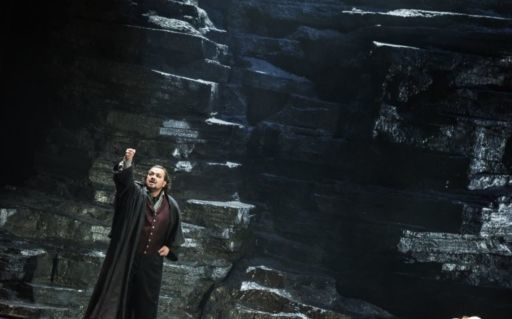 Höhepunkt der kongenialen Zusammenarbeit zwischen Richard Strauss und seinem Librettisten Hugo von Hofmannsthal gelten, hatten sie doch Mozarts Zauberflöte als Modell vor Augen: ein Märchen mit stark moralischer Dimension. Obgleich die Erzählung weitgehend Hofmannsthals Erfindung ist, stützte er sich auf eine Reihe von Quellen von Tausendundeiner Nacht bis zu Grimms Märchen. FroSch – wie Strauss das Vorhaben abzukürzen pflegte – ist neben Salome und Elektra eine der mächtigsten und anspruchsvollsten Partituren des Komponisten, aber im Gegensatz zu den anderen beiden ist sie eher ausgeklügelt und komplex als klar und kompakt. An diesem Punkt kommt ein guter Opernregisseur ins Spiel und Claus Guth ist zweifelsohne einer. Sein Ansatz ist einfach aber wirksam, er erzählt die Geschichte auf direkte Art und vermeidet die Gefahr, Hofmannsthals Neigung zum Obskuren wiederum zu verschleiern. Er eröffnet mit einer stummen Szene bevor die Musik einsetzt: eine Frau wird im Sanatorium behandelt. Sie durchlebt die Handlung in ihren Träumen, ungeachtet dessen, ob sie darin zur Kaiserin wird oder sie immer schon war. So kann Guth einfach die Geisterwelt von Kaiserin und Kaiser mit dem Alltagsleben des Färbers und seiner Frau in Verbindung bringen. Während die Kaiserin fast die ganze Zeit auf der Bühne ist, malt er Szenen der Vorgeschichte aus mit der weißen Gazelle (die Kaiserin bevor sie vom Kaiser entdeckt und erjagt wurde), der schwarzen Gazelle (Keikobat, der Vater der Kaiserin) und dem Falken, der den Kaiser zur weißen Gazelle führt. Die
Höhepunkt der kongenialen Zusammenarbeit zwischen Richard Strauss und seinem Librettisten Hugo von Hofmannsthal gelten, hatten sie doch Mozarts Zauberflöte als Modell vor Augen: ein Märchen mit stark moralischer Dimension. Obgleich die Erzählung weitgehend Hofmannsthals Erfindung ist, stützte er sich auf eine Reihe von Quellen von Tausendundeiner Nacht bis zu Grimms Märchen. FroSch – wie Strauss das Vorhaben abzukürzen pflegte – ist neben Salome und Elektra eine der mächtigsten und anspruchsvollsten Partituren des Komponisten, aber im Gegensatz zu den anderen beiden ist sie eher ausgeklügelt und komplex als klar und kompakt. An diesem Punkt kommt ein guter Opernregisseur ins Spiel und Claus Guth ist zweifelsohne einer. Sein Ansatz ist einfach aber wirksam, er erzählt die Geschichte auf direkte Art und vermeidet die Gefahr, Hofmannsthals Neigung zum Obskuren wiederum zu verschleiern. Er eröffnet mit einer stummen Szene bevor die Musik einsetzt: eine Frau wird im Sanatorium behandelt. Sie durchlebt die Handlung in ihren Träumen, ungeachtet dessen, ob sie darin zur Kaiserin wird oder sie immer schon war. So kann Guth einfach die Geisterwelt von Kaiserin und Kaiser mit dem Alltagsleben des Färbers und seiner Frau in Verbindung bringen. Während die Kaiserin fast die ganze Zeit auf der Bühne ist, malt er Szenen der Vorgeschichte aus mit der weißen Gazelle (die Kaiserin bevor sie vom Kaiser entdeckt und erjagt wurde), der schwarzen Gazelle (Keikobat, der Vater der Kaiserin) und dem Falken, der den Kaiser zur weißen Gazelle führt. Die 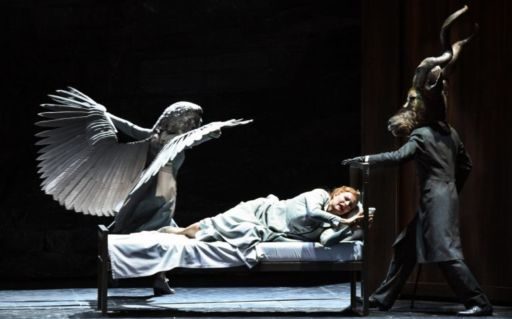 mephistophelische Amme agiert in beiden Welten, manchmal mit Flügeln wie eine Fledermaus oder ein Vampir. Die Inszenierung regt stark zum Nachdenken an, aber verliert nie die menschlich ergreifenden und wesentlichen Züge des vielschichtigen allegorischen Märchens. Christian Schmidts stilvolle Bühne und seine Kostüme sehen wunderschön aus mit halbrunden Wandelementen aus Holz, die leicht für die verschiedenen Szenen umgebaut werden können und von Olaf Winter eindrucksvoll ausgeleuchtet sind. Mir gefallen die mehr als angebrachten Schattenspiele besser als Andi A. Müllers Videoprojektionen von Fischen oder Spermien und schreienden Föten im Mutterleib. Simone Young dirigiert die Staatskapelle Berlin mit angenehmer, kenntnisreicher Selbstverständlichkeit. Sie entwickelt den großen Strauss-Klang der 120 Instrumente, Dissonanz und Harmonie gehen Hand in Hand und das Solospiel von Violine, Cello, Fagott
mephistophelische Amme agiert in beiden Welten, manchmal mit Flügeln wie eine Fledermaus oder ein Vampir. Die Inszenierung regt stark zum Nachdenken an, aber verliert nie die menschlich ergreifenden und wesentlichen Züge des vielschichtigen allegorischen Märchens. Christian Schmidts stilvolle Bühne und seine Kostüme sehen wunderschön aus mit halbrunden Wandelementen aus Holz, die leicht für die verschiedenen Szenen umgebaut werden können und von Olaf Winter eindrucksvoll ausgeleuchtet sind. Mir gefallen die mehr als angebrachten Schattenspiele besser als Andi A. Müllers Videoprojektionen von Fischen oder Spermien und schreienden Föten im Mutterleib. Simone Young dirigiert die Staatskapelle Berlin mit angenehmer, kenntnisreicher Selbstverständlichkeit. Sie entwickelt den großen Strauss-Klang der 120 Instrumente, Dissonanz und Harmonie gehen Hand in Hand und das Solospiel von Violine, Cello, Fagott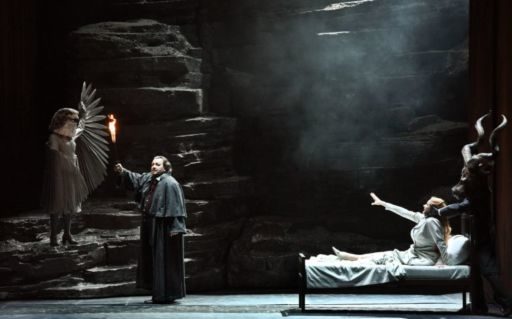 und Horn ist grandios. Auch die Besetzung ist durchweg erstklassig. Angesichts der enormen stimmlichen Anforderungen der einzelnen Partien, kann ich mir heutzutage keine bessere Besetzung vorstellen. Auf die Titelrolle war fast 30 Jahre lang die unvergessene Leonie Rysanek abonniert. Camilla Nylund steht auch im stimmlichen Mittelpunkt und wiederholt ihre außergewöhnliche Kaiserin des Premierendurchlaufs letztes Jahr. Ihre tadellose Technik und ihr geradezu endloses stimmliches Durchhaltevermögen sind bewundernswert, was ihr die hohe Soprantessitur mit Koloraturen, Trillern und einem makellosen hohen D wie auch dramatische Ausbrüche erlaubt. Und sie hat noch die Kraft, die große Szene “Vater, bist du’s?” zum Höhepunkt des dritten Aktes zu machen. Bravo! Elena Pankratova ist nicht weniger faszinierend als tief fühlende Färberin. Ihr voller und ausdrucksstarker Sopran bietet die perfekte Mischung von warmem Timbre und Tonschönheit, die Stimme ist den dick orchestrierten Stellen gewachsen und schwingt sich mühelos in die Höhe, so dass das zusammen mit der Kaiserin gesungene finale C zu einer Klangorgie gerät, wie man sie seit der Ära Nilsson/Rysanek kaum mehr gehört hat. Michaela Schuster ist eine großartige Darstellerin, um die Amme die Fäden ziehen zu lassen und ihr stählerner Mezzo vermittelt überzeugend die doppelbödige Bosheit der Figur. Es mag nur eine Handvoll Sänger geben, die die furchterregende Partie des Kaisers stemmen können. Simon O’Neill ist einer davon und in der Lage, das schwere orchestrale Gefüge mit seinem hell fokussierten und kraftvollen Tenor im obersten Register zu durchmessen. Baraks aufrichtig menschlicher Charakter macht ihn uns von vornherein sympathisch und Egils Silins als einer der gesuchtesten Färber der letzten zehn Jahre, liefert ein bezwingendes Rollenporträt zwischen Verzweiflung und Hoffnung, sein Dilemma scheint real. Sein Bassbariton mit genügend Kraft klingt weich und reif mit leicht nordischem Touch. Auch in den kleineren Partien gibt es ausgezeichnete Leistungen wie Boaz Daniels geflügelter Geisterbote, Jun-Sang Hans Jüngling oder Slávka Zámečníkovás Falken, um nur einige zu nennen. Photo Hans Jörg Michel
und Horn ist grandios. Auch die Besetzung ist durchweg erstklassig. Angesichts der enormen stimmlichen Anforderungen der einzelnen Partien, kann ich mir heutzutage keine bessere Besetzung vorstellen. Auf die Titelrolle war fast 30 Jahre lang die unvergessene Leonie Rysanek abonniert. Camilla Nylund steht auch im stimmlichen Mittelpunkt und wiederholt ihre außergewöhnliche Kaiserin des Premierendurchlaufs letztes Jahr. Ihre tadellose Technik und ihr geradezu endloses stimmliches Durchhaltevermögen sind bewundernswert, was ihr die hohe Soprantessitur mit Koloraturen, Trillern und einem makellosen hohen D wie auch dramatische Ausbrüche erlaubt. Und sie hat noch die Kraft, die große Szene “Vater, bist du’s?” zum Höhepunkt des dritten Aktes zu machen. Bravo! Elena Pankratova ist nicht weniger faszinierend als tief fühlende Färberin. Ihr voller und ausdrucksstarker Sopran bietet die perfekte Mischung von warmem Timbre und Tonschönheit, die Stimme ist den dick orchestrierten Stellen gewachsen und schwingt sich mühelos in die Höhe, so dass das zusammen mit der Kaiserin gesungene finale C zu einer Klangorgie gerät, wie man sie seit der Ära Nilsson/Rysanek kaum mehr gehört hat. Michaela Schuster ist eine großartige Darstellerin, um die Amme die Fäden ziehen zu lassen und ihr stählerner Mezzo vermittelt überzeugend die doppelbödige Bosheit der Figur. Es mag nur eine Handvoll Sänger geben, die die furchterregende Partie des Kaisers stemmen können. Simon O’Neill ist einer davon und in der Lage, das schwere orchestrale Gefüge mit seinem hell fokussierten und kraftvollen Tenor im obersten Register zu durchmessen. Baraks aufrichtig menschlicher Charakter macht ihn uns von vornherein sympathisch und Egils Silins als einer der gesuchtesten Färber der letzten zehn Jahre, liefert ein bezwingendes Rollenporträt zwischen Verzweiflung und Hoffnung, sein Dilemma scheint real. Sein Bassbariton mit genügend Kraft klingt weich und reif mit leicht nordischem Touch. Auch in den kleineren Partien gibt es ausgezeichnete Leistungen wie Boaz Daniels geflügelter Geisterbote, Jun-Sang Hans Jüngling oder Slávka Zámečníkovás Falken, um nur einige zu nennen. Photo Hans Jörg Michel
